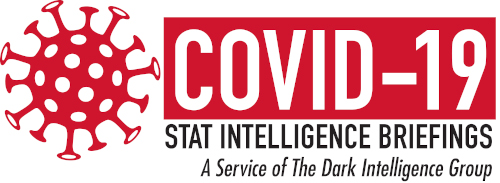Saliva recently became available as a specimen type for SARS-CoV-2 analysis, starting with an EUA granted to Rutgers Clinical Genomics Laboratory, where a fully automated nucleic acid extraction workstation, such as the one shown above, reportedly can process up to 10,000 saliva samples per day. Clinical laboratories and pathology groups should be aware of the emerging benefits of the utilization of saliva as a COVID-19 testing specimen.
With COVID-19 testing technology rapidly developing, an emerging area of interest has been the utilization of saliva as a testing specimen. The COVID-19 STAT Intelligence Briefings Service interviewed Frederick (Fritz) Kiechle, MD, PhD, to learn more about the impact that saliva specimen testing will have on clinical laboratories.
Now Medical Director at Boca Biolistics in Pompano Beach, Florida, Kiechle is one of the first pathologists in the US to set up molecular testing in a hospital laboratory. Within the pathology profession, he is considered a go-to expert on matters relating to collecting, transporting, and preparing medical laboratory specimens for analysis. He has written several textbooks on this subject.
“There are an increasing number of references discussing the use of saliva as a SARS-CoV-2 specimen, and the bulk of them are basically saying that saliva is equally as good, or perhaps better than, nasopharyngeal swabs,” Kiechle said. “We can definitely do PCR testing off of saliva, but it is looking more and more likely that we can get both RNA and antibodies off of saliva.”

For COVID-19 STAT, Frederick (Fritz) Kiechle, MD, PhD, now Medical Director at Boca Biolistics in Pompano Beach, Florida, explained the emerging use of saliva as a sample type for detecting SARS-CoV-2, the strain of coronavirus that causes COVID-19. (Photo copyright: The Dark Intelligence Group)
Considerations When Collecting Saliva Samples for SARS-CoV-2 Analysis
Kiechle explored some of the considerations when collecting saliva specimens. “You can’t eat anything, drink anything, or smoke for 10 minutes before,” Kiechle explained. “It’s not a long period of time.”
“For chemical analysis some people have said that it’s better to freeze the specimen and then thaw the specimen with centrifuging, which will then precipitate the interfering glycoprotein,” Kiechle told STAT COVID-19. “This provides a less viscous sample for testing. As most of these saliva samples are very viscous, they might not work very well. That’s a collection issue, and there’s a question about whether that’s important or not in the business.”
While the need for freezing and thawing a saliva sample immediately after collection has the potential to be a barrier for use, Kiechle did highlight a new saliva collection product that appears to circumnavigate this problem.
“It’s a pretty cool device. It’s made by DNA Genotek from Canada. The product is called Oragene-Dx for collection of microbial RNA and DNA,” Kiechle said. “It has a tube that you collect the saliva in; it has a little opening where you can easily get your mouth around it and get the saliva into the tube. There’s a mark for the full line, and then there’s a little blister pack that’s attached to the end of this thing, which you would flip over and pop open, and it contains some mystery compounds that they’re not talking about, but they stabilize the DNA and the RNA in the specimen.” The key benefits of this product are that it does not dilute the specimen and seems to not require freezing and thawing.
Saliva has only recently become available as a specimen for SARS-CoV-2 analysis, starting with an emergency use authorization (EUA) for saliva assays being granted to Rutgers Clinical Genomics Laboratory on May 8, 2020.
Timothy Stenzel, federal Food and Drug Administration (FDA) Director of the Office of In Vitro Diagnostics and Radiological Health, recently addressed the FDA’s position on EUAs for saliva testing during a CDC Town Hall held June 8, 2020.
“Saliva can be added without an EUA by laboratories when it is a modification to an already-authorized EUA,” Stenzel told listeners. “The addition of saliva can be validated per recommendations in the guidance and in the template. Manufacturers are required to seek EUA authorization for saliva. So again, labs can validate and do not require an EUA. We’re happy to look at it, though, for an EUA, if they wish.”
Testing Saliva for SARS-CoV-2: Implications for Clinical Laboratories
“The big advantage of saliva testing is that if you can use saliva as a sample you don’t have to collect a specimen by doing a brain biopsy, like an NP swab,” Kiechle humorously explained. “All you’re doing is asking them to spit into a container. And that particular material is the same material you’re collecting on an NP or OP [naso or oropharyngeal] swab. It turns out to be better than, or at least just as good as, the NP swab which everybody thinks is the gold standard.”
Saliva may provide an easier, more comfortable method of at-home collection. “It has been utilized very effectively for home analysis,” Kiechle told COVID-19 STAT.
Another benefit for saliva specimens is a potentially decreased risk of transmission. “When you’re collecting an NP swab, you and the patient are very close to each other,” Kiechle described, “and you could be transmitting the disease. With saliva collection you’re going to avoid that altogether. They can collect this at home too; they don’t actually need to be in front of you to do it.”
Reuters reports that a weekly coronavirus testing regime, using a “no-swab” saliva test with a technique called RT-Lamp, is being piloted in southern England. One of the goals of the trial is to determine whether routine, at-home testing could pick up cases of the virus earlier, according to the Reuters’ article June 22 that quoted British Health Secretary Matt Hancock and also stated that the pilot program will involve further validation of the technique against PCR nasal swabs.
As the use of saliva as a specimen type becomes more prevalent in SARS-CoV-2 testing, clinical laboratory leaders should be aware of the impact that this could have on clinical laboratory workflow, in the overall testing strategy of patient populations, and in the potential for expanded at-home COVID-19 testing.

—By Caleb Williams, Editor, COVID-19 STAT
Related Resources:
Rutgers Clinical Genomics Laboratory saliva testing EUA






